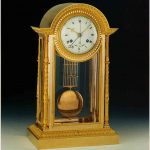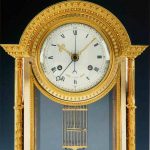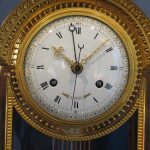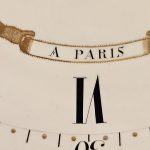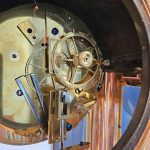An architecturally shaped regulator enamelled by Merlet

Pendule ancienne
A Louis XVI two-tone yellow and pink gilt bronze architecturally shaped regulator,
glazed on all sides, indicating the date and in the central ring the seconds,
the dial signed à Paris, the enamel signed by the enameller G. Merlet – circa 1785-1790
Height: 52.4 cm. (20 ½ in.) Width: 31.4 cm. (12 ¼ in.) Depth: 17.6 cm (7 in.
Georges-Adrien Merlet (1754 – circa 1802)
The enamelled dial bearing the signature, with Roman numerals indicating the hours and Arabic numerals for the quarter hours and date with pierced and engraved gilt brass hands. The circular movement has a pinwheel escapement and knife suspension of the grill pendulum. The clock chimes the hours and half hours by means of a count-wheel mounted on the back plate.
Provenance
Rieunier Bailly Pommery, Drouot, Paris, 12 December 1997, lot 118 (€29,574)
Literature
- and A. Wannenes, Les plus belles pendules Françaises, Florence, 2013, p. 293 (ill.)
Comparative Literature
Similar regulators currently known include:
- One delivered on 1 Frimaire An XIII (22 November1804) for the Cabinet de l’Empereur at the Palace of Fontainebleau, illustrated in J.-P. Samoyault, Pendules et bronzes d’ameublement entrés sous le Premier Empire. Musée national du Château de Fontainebleau, Paris, 1989, p. 66, no. 27 (signed Lepaute à paris, indicating the date and the phases of the moon).
- One from the Louis XVI period formerly in my gallery (signed à Paris, the enamel signed by the enameller Dubuisson, indicating the date and in the central ring the seconds, pinwheel escapement and knife suspension of the grill pendulum).
- One illustrated in P. Kjellberg, Encyclopédie de La Pendule Française, p. 325, D (signed de Kinable, indicating the date and in the central ring the seconds).
Georges-Adrien Merlet (1754 – circa 1802)
Georges-Adrien Merlet was one of the finest Parisian enamellers of the 18th Century, a colleague and competitor of Joseph Coteau, Barbichon, and Etienne Gobin (known as Dubuisson). His best-known works include decorative clock dials, particularly skeleton clocks, which he usually signed G Merlet or GM. He collaborated on clocks with the bronziers, Jean-André Reiche and Claude Galle, as well as the marchand-mercier, Dominique Daguerre. He worked with numerous clockmakers, including Renacle-Nicolas Sotiau, Charles-Guillaume Hautemanière (known as Manière), Jacques-Thomas Bréant, Lepaute, Robert Robin, Laurent Ridel, Pierre-Claude Raguet-Lépine, and Nicolas-Aléxandre Folin.

